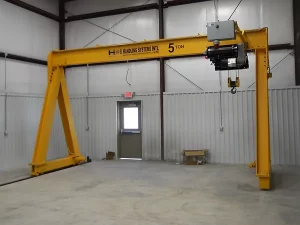
A gantry crane is a crane that is built on a gantry or portable frame, typically on wheels (though they can also come on tracks or rail systems). These cranes are highly versatile and can be used in smaller operations like automotive shops and large-scale operations.
Gantry cranes are available in a number of configurations. Motorized gantry cranes with track systems allow smooth positioning. On the other hand, trackless gantry cranes (motorized or manual) can be motorized or travel in any direction. Gantry cranes can also be single or double girder. Single girder cranes are great for lighter lifting requirements, and double girder models are ideal for high-capacity and more intensive operations.
Regardless of the type of gantry crane you choose, these cranes offer versatility and mobility, excellent lifting capabilities, higher efficiency, and cost effectiveness.
How does a gantry crane work?
Gantry cranes feature legs (two vertical supports on either side of the crane), a bridge (the main horizontal beam), a trolley (that moves along the bridge), a hoist (that lifts and lowers the load), and a track or casters (which move the whole structure).
This system supports both vertical and horizontal movement. The hoist, attached to the trolley, lifts and lowers while carrying heavy objects as needed. The trolley can move horizontally across the bridge, while the entire crane and support can move horizontally along the track or casters.
What are the benefits of a gantry crane?
Gantry cranes move on wheels, tracks, or rail systems, which means they’re completely mobile. Additionally, they’re not permanent structures, so they can be assembled relatively quickly compared to other cranes that require foundations or permanent installation. Lastly, gantry cranes are extremely customizable, meaning you can choose the height, span, and wheels or casters that meet your needs.
FILTER